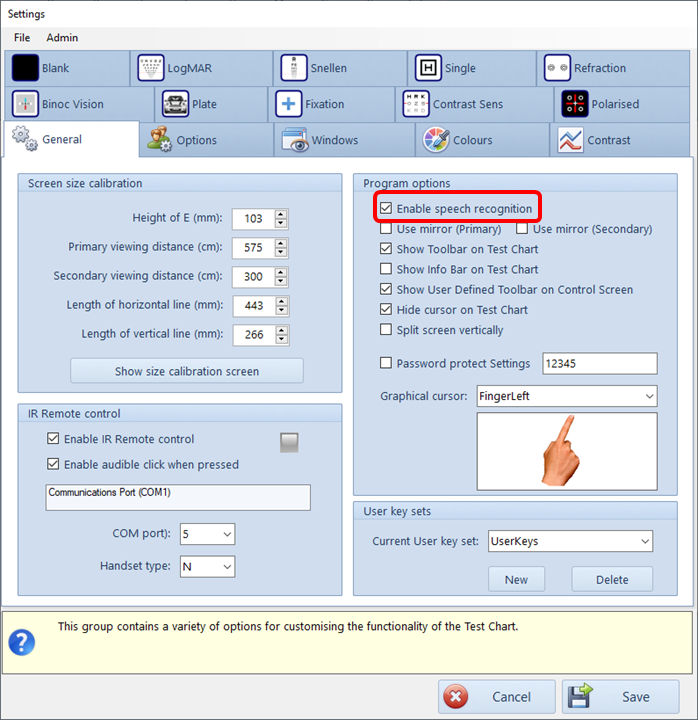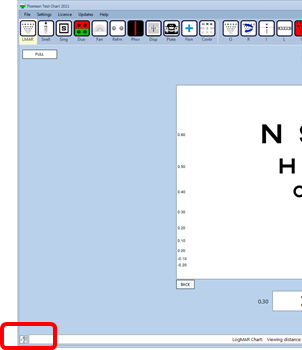Using speech control
The Thomson Test Chart may be operated using speech control. This is particularly useful when conducting clinical procedures such as retinoscopy, when it may be difficult to simultaneously operate the mouse, keyboard or remote control.
To enable speech control, select Settings... General and ensure that Enable speech recognition is ticked (as shown below)

The accuracy of the speech recognition will depend on the quality of the sound received which in turn will depend on the microphone and the level of ambient noise.
To instruct the system to start "listening", you should say "SPEECH ON". To stop listening say "SPEECH OFF". A listening icon will appear on the Control Window to indicate when listening is turned on (see below).

All speech commands relating to the Test Chart must be given the prefix "CHART".
Speech commands mainly follow the naming conventions shown in the toolbar (with a few additions for clarity).
To select the Primary modes, use the following commands:
"Chart-Snellen"
"Chart-Single"
"Chart-Duochrome"
"Chart-Fan"
"Chart-Refraction"
"Chart-Phoria"
"Chart-Disparity"
"Chart-Binocular-Vision"
"Chart-Plate"
"Chart-Fixation"
"Chart-Contrast-Sensitivity"
"Chart-Polar"
"Chart-Polarised",
To Blank or Un-blank the screen say:
"Chart-On"
"Chart-Off"
To Split or Un-Split the screen say:
"Chart-Split"
"Chart-Un-Split"
When in Split mode, select the Upper/Lower charts by saying:
"Chart-Top",
"Chart-Bottom"
In each primary mode, the command have the same effect as the secondary toolbar buttons/keys although several voice commands are available for some of the commands for clarity.
The commands are as follows:
R: "Chart-Randomise", "Chart-R", "Chart-Reveal","Chart-Rotate",
O: "Chart-Default","Chart-O",
I: "Chart-Column","Chart-I"
L: "Chart-Row", "Chart-L",
U: "Chart-U",
M: "Chart-M", "Chart-Coloured",
C: "Chart-C",
G: "Chart-Crowded", "Chart-G", "Chart-Contrast",
Up: "Chart-Bigger", "Chart-Up",
Down "Chart-Smaller", "Chart-Down",
Left: "Chart-Left",
Right: "Chart-Right",
Home: "Chart-Home",
End: "Chart-End",
1: "Chart-One",
2: "Chart-Two",
3: "Chart-Three",
4: "Chart-Four",
5: "Chart-Five",
6: "Chart-Six",
7: "Chart-Seven",
8: "Chart-Eight",
9: "Chart-Nine",
10: "Chart-Ten",
Esc: "Chart-Escape",
Optotypes
Sloan: "Chart-Sloan",
British: "Chart-British",
Tumbling E: "Chart-Tumbling",
Tumbling E 2: "Chart-Tumbling-Two",
Landolt C: "Chart-Landolt",
Auckland: "Chart-Auckland",
Kay: "Chart-Kay",
Kay (Old): "Chart-Kay-Old",
Sheridan-Gardner: "Chart-Sheridan",
Lower case: "Chart-Lower-case",
Makaton: "Chart-Makaton",
Numbers: "Chart-Numbers",
User defined keys
0: "User-Nought",
1: "User-One",
2: "User-Two",
3: "User-Three",
4: "User-Four",
5: "User-Five",
6: "User-Six",
7: "User-Seven",
8: "User-Eight",
9: "User-Nine"}